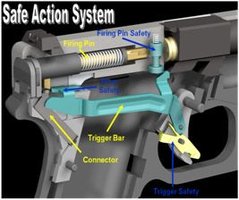What makes an M&P safer than a Glock? How do other striker fired firearms not ever fall under the same scrutiny as Glocks?
?
In MA? Fagmags - you can only shoot yourself 10 times vs. 17. Obviously a lot safer.
![Wink [wink] [wink]](/xen/styles/default/xenforo/smilies.vb/002.gif)
If you enjoy the forum please consider supporting it by signing up for a NES Membership The benefits pay for the membership many times over.
Be sure to enter the NES/MFS May Giveaway ***Canik METE SFX***
What makes an M&P safer than a Glock? How do other striker fired firearms not ever fall under the same scrutiny as Glocks?
?
![Wink [wink] [wink]](/xen/styles/default/xenforo/smilies.vb/002.gif)
Not to derail this, but Ive been looking online at cut away's and diagrams of Glock internals, but I don't understand how the drop safety works on one of them. (Maybe its because I'm not holding one looking at it). Anyone here have a simple explanation? Out of curiosity, does the M&P have some equivalent?
If you saw a cut away model or animation - you would realize that the Glock is the safest gun in the world. It is impossible to fire it without pulling the trigger.
The "drop safety" is the geometry of the channel in which the cruciform sear plate rides, which is designed to prevent the sear plate from disengaging from the tab on the striker unless the sear plate is in the forward position.
I know the innards of a Glock.
Others are impossible to fire even if you do pull the trigger.
Which is safer?
I know the innards of a Glock.
Others are impossible to fire even if you do pull the trigger.
Which is safer?
There is obviously no room for error when it comes to trigger discipline with glocks, the same goes for reholstering.
I know the innards of a Glock.
Others are impossible to fire even if you do pull the trigger.
Which is safer?
I don't agree. I was creating lots of error in my video and the trigger never broke. I was being quite aggressive with that trigger. That was sort of my point in the video, their is room for casual error. Not that anyone should ever do this on purpose. Stay off the trigger obviously.
Clothing; yes you must be very careful.
The uselessness of the video is only surpassed by this stupid argument
Next time I'll check with you first to see if it's worthy.
Thank you, that makes the pictures I was looking at make significantly more sense.
Working from memory, the M&P does not have anything similar...
The m&p has a plunger that blocks the firing pin. There's a tab on the trigger bar that pushes it out of the way when the trigger is pressed.
Sent from my PG06100 using Tapatalk
Do some research on the Glock "Safe Action System".
The Trigger Safety, Firing Pin Safety, and Drop Safety all work together.
If you saw a cut away model or animation - you would realize that the Glock is the safest gun in the world. It is impossible to fire it without pulling the trigger.

